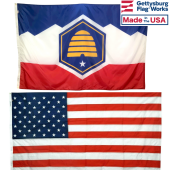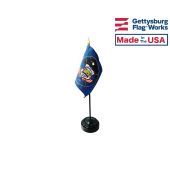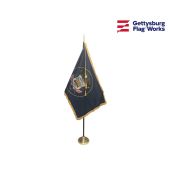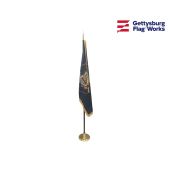Utah State Flag
- New Utah State Outdoor Flag - Utah Beehive Flag 2024Starting at $24.95
-
-
-
-
-
State Flag of Utah
The Utah state flag has been in use for less than a decade, which makes it one of the youngest flags in the United States. It bears a very strong resemblance to the state flag of Utah that is replaced, which had represented the state of Utah for almost a century.
Colors and Symbolism of the Utah State Flag
Utah state flags follow the same pattern as many other state flags in the United States of America. They have a dark blue field that displays the state's seal surrounded by a golden ring in the center of the flag. The state's seal includes a bald eagle, which is a symbol of protection. It also features the state's official flower, the sego lily. The lily serves as a symbol of peace as well as a symbol of the state of Utah. It is accompanied by a beehive, which is a symbol of productivity, and the state's motto, "Industry." The year that the state joined the Union is at the bottom of the seal, and the seal is flanked by a pair of American flags that represent Utah's dedication to the rest of the nation.
History of Utah State Flags
The first of the Utah state flags came into use in 1903. It had the same general design ask the current state flag of Utah, but it used a simplified form of the state's seal that was depicted entirely in white. The flag only represented Utah for a single decade before it was replaced.
The 1913 Utah state flag was designed by accident. The Daughters of the American Revolution had purchased a copy of the flag as a gift for a battleship, but the manufacturer had depicted the state seal in full color and surrounded it with a golden ring. The Daughters of the American Revolution proposed that the state government should adopt their flag's accidental design as the new pattern for all state flags, and the voted in favor of their proposal.
The flag changed slightly in 2011 in order to fix another mistake. Most of the flags that were in use had been based on single flag that had placed a date in the wrong place on the flag, which meant that very few Utah state flags existed that followed the proper pattern. The 2011 law amounted to a change in the design because essentially every flag had been using the same incorrect pattern, and the flag has not changed since it passed into law.
A short history of the Utah State flag
In 1847 the first Mormons entered Salt Lake City when it was still part of Mexico, and still remains the largest religious body in the state. In 1848 the Mormons founded a state which they named "Deseret" (meaning honeybee). Appearing on both the state flag and seal was the Mormon's emblem, which was a beehive. In 1849, the area was declared a Territory with the new name of Utah. The canton of the flag was changed so the cannon no longer appeared, and this flag was used until 1860. The state seal was adopted in 1850 and has a coat of arms consisting of a shield containing a beeehive with sego lilies on either side. The lilies were eaten by the early settlers when they ran out of food, and are therefore commemorated. the state seal motto is above the beehive, and the name of the state is below it. There is an American flag on either side of the shield, and the crest is an eagle grasping some arrows. Until the Daughters of the American Revolution designed a new flag, (one with the arms of the seal in white on a blue field), there was no flag. The new flag was adopted in March 1911, and changed in March 1913 to the present flag with the arms in color within a thin gold circle.
A short history of Utah (The Beehive State)
Part of a huge area of Mexico, and ceded to the USA in 1848, which was after the Mormons had founded Salt Lake City in 1847. The Mormon polygamy prevented entry to the Union until January 4, 1896.
Area of Utah: 84,899 sq. miles
Capital: Salt Lake City
Major Products: copper, gold, oil, gas, barley, wheat, primary metals, fabricated metals and machinery
State Motto: Industry






















